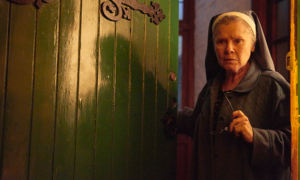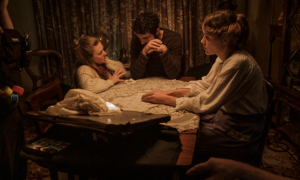Written and directed by Romola Garai, Amulet explores the story of Tomaz (Alec Secareanu, Cannibal), an ex-soldier from an unnamed foreign conflict, living in strained circumstances in London. Haunted by his past, he is offered a place to stay in a decaying, claustrophobic house by Sister Claire (Imelda Staunton, Harry Potter and the Order of the Phoenix) which is inhabited by an enigmatic young woman (Carla Juri, Blade Runner: 2049 – pictured above, left) and her dying mother.
However, Tomaz cannot ignore his suspicion that something insidious might also be living alongside them, even he starts to fall for his new companion.
We speak to Romola Garai (pictured above, right) about making her first feature film, how important the creatures were in Amulet, and not filming in Epping Forest…
When did you first get the idea for Amulet?
It was maybe four years ago. I had been working on lots of different projects, trying to make my first feature. Then people started being really excited by women working in the genre space and somebody said to me: ‘Have you thought about writing a horror film?’
A lot of my scripts were very dark. A couple of them were ghost stories, or more like supernatural thrillers or psychological mysteries. But I hadn’t made something that was all-out horror. Then I thought, ‘well, I love horror films’. It’s always been a big thing that I’ve been really into and then I just sort of sat down to write one!
How long did the script take you to write?
It happened quickly. I wrote it in three weeks. Which is really fast. Then I immediately was able to get interest in it and have conversations about it really quickly, and early on.
When I look back on the screenplay, I think there were a lot of different things that were obviously going on in it. It’s obviously a bit about birth. It’s a bit about transformation. It’s a bit about, I guess, righting the wrongs of the past. How do you, as a woman, move forward in a world, loving and acknowledging men and also acknowledge the fact of living in a patriarchy and this massive history of male violence? How do you exist in that? So there were lots of different things that when I look back, we’re kind of going on in the script…
What is it about genre that appealed to you as a writer?
Well, I think partly it’s to do with creatures, and the role that creatures play. You can’t have creatures, you can’t really have anything supernatural, in a drama, obviously. I mean, a couple of scripts that I’d had before had ghosts in them, but I see the creatures in this film as an extension of that. They’re something that comes from inside the character, and comes out. They’re like the secrets, the misdeeds, the crimes of the past that are coming to the fore.
I like to have something very extreme happen on the screen. I have a taste for that. If you’re going to talk about deep pain and suffering, or very extreme human emotions, I like to see them realised on film.
Ever since I was a child, I liked myths. I liked fairy tales. I have an appetite for that. So when I watch a Cronenberg film or when I see a character go through a physical transformation or a very extreme thing happens, like a creature crawl out of a toilet and you don’t know what it is, that weirdly for me feels like a more accurate description of the human experience than sometimes when you watch a drama and there are three people sat around a table talking.
To me, it’s often more difficult to create the experience of what it means or feels like to be alive in the world. Not always. I mean, obviously, you can see dramatic films that make you feel very intense feelings, but I feel like there’s not always the kind of extremity of feeling in those movies.

There are some weird and wonderful creatures in Amulet. How involved were you in creating them?
Very involved. That was the part of the film I was most excited to do. The stage directions for the creature that comes out of the toilet were a page long! I had a very strong idea of what I wanted it to look like. It had to be something that on some level, you could sort of believe was just a normal thing. It couldn’t be so fantastical that you’re running around in the streets calling the neighbours or ringing the police; they have to accept it on some level, but also it looks strange enough that they know that something is wrong.
Then the birth sequence, I was very involved with. I had such a strong idea of how I wanted the creature to move that I was underneath the floor in the set operating the little puppet!
It was hugely important to me that those sequences felt physical. I didn’t want it to be all effects. I wanted there to be real creatures that the actors could really interact with and that the audience understood were physical objects.
Obviously we do use visual effects at the end though…
Amulet is primarily set in one house. Was much of that house built for the movie?
We only built the attic. Everything else was a real house and it was really hard to find! We were weeks away from starting filming and we still we still didn’t have it, and the production designer hadn’t been able to do anything, make anything and it was really really difficult.
What happens is that you go on location websites and everything’s been used. You’ve seen all of the spooky houses. You’ve seen them all and then you’re just trying to find a disused building in London or a disused house in London, which is obviously going through a massive property crisis where there’s just not enough housing.
Then obviously there’s the issue of size because any kind of normal size London house is going to be too small. You physically wouldn’t be able to film it and fit the crew in it. Everything on screen is slightly bigger than then what it is in real life. So then that was that issue. It was very naive for me to think that we could just go and find a dilapidated house and move in for a month!
But then we were incredibly lucky. We found a building that was absolutely perfect. Someone had bought it. They were about to do it up, but they hadn’t started yet. They basically said ‘sure, we’ll wait a month and let you make your film’. So yeah, we got very lucky in the end!

What was your biggest challenge when filming Amulet?
I think that the biggest challenge for me was working out the stuff that was really important and that you have to fight for and then working out what you can just let go. No one really gives you a lesson in that. When I had spoken to directors about making my first feature, people said just be really prepared. Make sure you storyboard. Really think about music.
People had given me lots of amazing pointers but no one had said to me that when you make a feature, for your first feature, for 99% of people doing that, there are going to be things that are really important to you and you have to really protect them. That means you’re going to have to fight really hard for those things.
There are going to be things where you’re like ‘the car’s red, it’s not supposed to be red, it’s supposed to be blue’, and they’re like, ‘well the car’s blue’ and you’re gonna have to be, ‘okay, the car is blue’.
That for me was a challenge because nobody had really been able to tell me. Budget is such a vague thing for a director. There is money for the things that are really important to you, but not for other things and you have to navigate all of that. It’s complicated and no one can really tell you how to do it. You have to just learn it, and then once in a while, you have to be like, ‘no, the car has to be red’ and then everybody has to sit around and wait while they get another car. I found that really difficult.
What in the movie was your ‘the car is red’ situation? What did you fight to keep in Amulet?
The flashback sequences. I had a very strong idea of how I wanted them to look. It would have made our film so much easier for everyone if we shot them in Epping Forest, but I was like ‘it cannot look like England, if it looks like England, it will be completely confusing, it has to be a pine forest’. So, we ended up going down to Dartmoor.
That was the last week for the film. We were really at the end of the year, it was the last week before Christmas, we had very little in the way of logistics, there wasn’t a toilet, and we were miles in the middle of the forest. It made things really hard for the crew. It is difficult when you’re standing there as a director and people are saying, ‘I can’t use the toilet. This would be much easier if we were in Epping Forest!’.
You have to be the person that says ‘it wouldn’t have looked as good, and it looks so much better’. So I fought really hard to shoot it in that location. But I’m really happy with that part of the film and I think it looks beautiful. So I’m glad I stood up for that.
What do you want for audiences to take away from Amulet?
I hope that they felt complicit. That’s the thing I would really like. I want the film to challenge people’s prejudices about what you see on screen and to use their critical faculties when they’re watching a film.
I want people to fall into all of those traps, because they’re tropes and they’re tropes for a reason. Cinema has such a problem with older women, and at one point in the film, it starts to reconfigure that information. I just hope that that works so that people do end up thinking, ‘hmm, yeah, why did I naturally assume all of the things that I assumed about those characters?’. That’s what I’m hoping that people take away from it…
Amulet is out in cinemas on 28 January 2022. Find out more, including showtimes, here.
